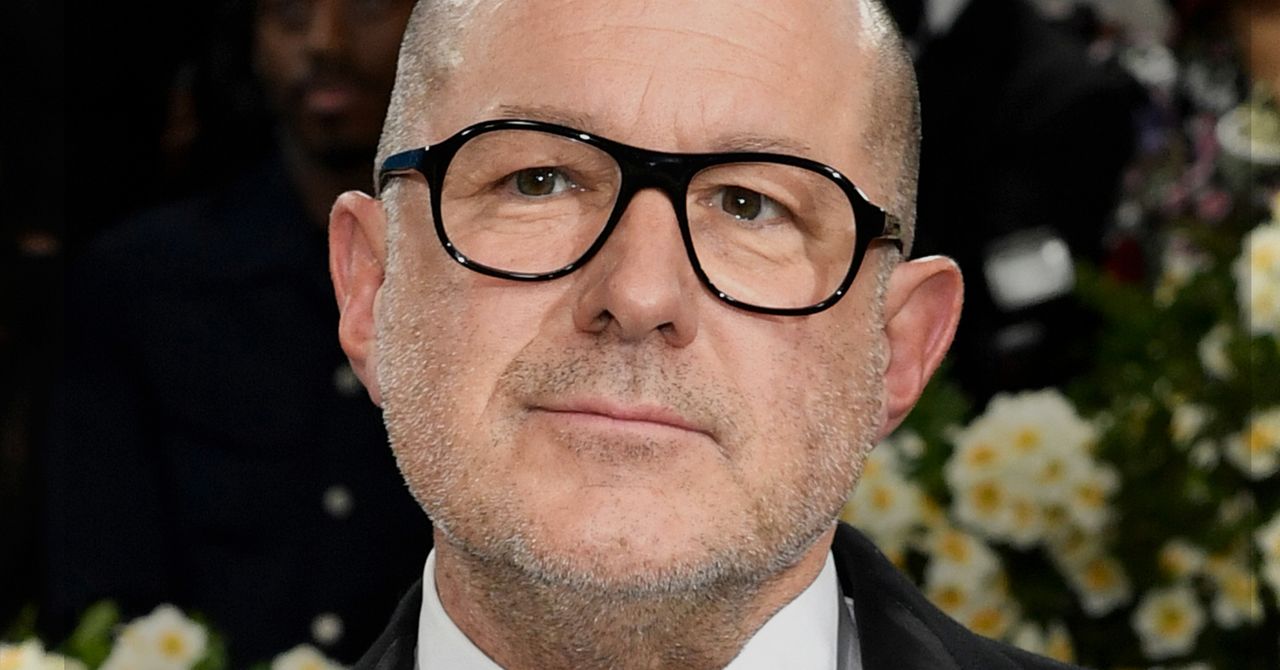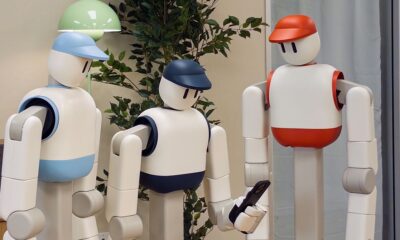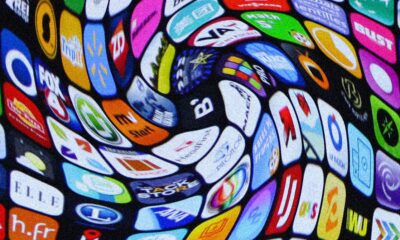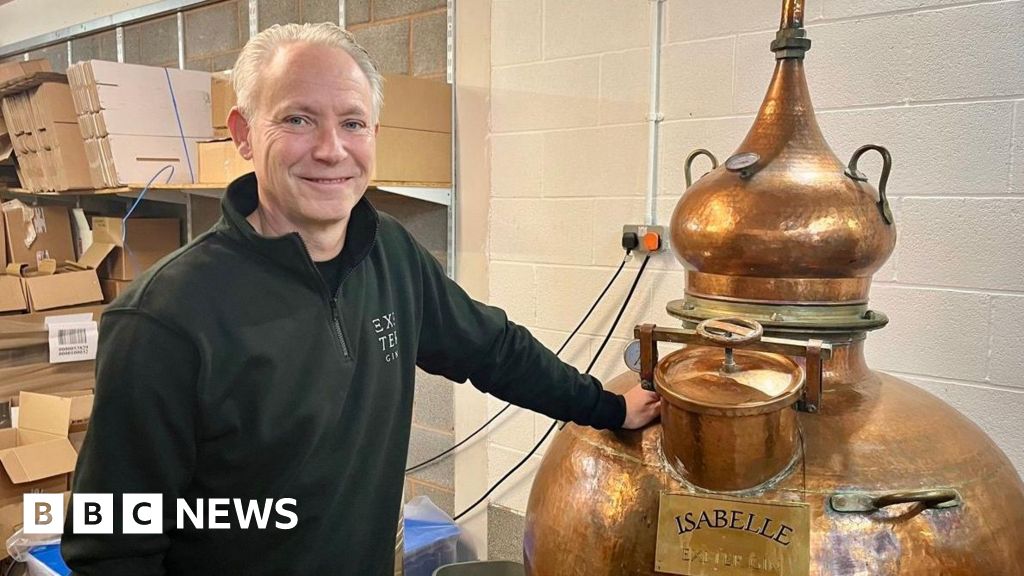Tech
Jony Ive Says He Wants His OpenAI Devices to ‘Make Us Happy’

At OpenAI’s developer conference in San Francisco on Monday, CEO Sam Altman and ex-Apple designer Jony Ive spoke in vague terms about the “family of devices” the pair are currently working to develop.
“As great as phones and computers are, there’s something new to do,” Altman said on stage with Ive. The duo confirmed that OpenAI is working on more than one hardware product but finer details, ranging from use cases to specifications, remain under wraps.
“Hardware is hard. Figuring out new computing form factors is hard,” said Altman in a media briefing earlier in the day. “I think we have a chance to do something amazing, but it will take a while.”
Ive said that his team has generated “15 to 20 really compelling product” ideas on the journey to find the right kind of hardware to focus the company’s efforts on.
“I don’t think we have an easy relationship with our technology at the moment,” said Ive. “Rather than seeing AI as an extension of those challenges, I see it very differently.” Ive explained that one reason he wanted to design an AI-powered device with OpenAI is to transform the relationship people currently have to the devices they use every day.
While Ive acknowledged the potential for AI to boost productivity, efficiency doesn’t appear to be his core goal with these devices. Rather, he hopes for them to bring more social good into the world. The devices should “make us happy, and fulfilled, and more peaceful, and less anxious, and less disconnected,” he said.
Earlier reporting indicated that OpenAI is planning to manufacture a new category of hardware that doesn’t resemble a phone or laptop. In a recent preview for OpenAI staff, Altman hinted that the product would be aware of a user’s surroundings and day-to-day experiences, according to The Wall Street Journal. The device might be screenless and rely on inputs from cameras and microphones.
OpenAI also hasn’t said publicly when it plans to launch the devices, though late 2026 may reportedly be the target launch, according to the Financial Times. The publication recently reported that development of the device has been stymied by technical issues.
Tech
Two Kitchen Robots Turned Me Into Their Prep Cook for Thanksgiving

The holiday is still almost a week away, and I’m sick of Thanksgiving. I’ve already made four rounds of mashed potatoes, three of mac and cheese, and three turkeys (with more still waiting in my fridge) as part of testing smart probes to help smoke turkeys outside and preparing seven-course holiday meal kits for friends and family.
I was eager to finally outsource some of the cooking by testing two very different robo-chef devices, the Thermomix TM7 and the Posha kitchen robot. Both promise to plan my meals and also do most of the cooking, which sounds pretty good to me.
The Thermomix descends from a German device launched in 1968—a time when the best-known robot chef was cartoon Rosie on The Jetsons—that was essentially a blender with a heater. It’s since caught on big in countries from Italy to Portugal to Australia, and over the years it’s added multi-tier steaming, baking, proofing, a touchscreen, an encyclopedic recipe app, and a whole lot of smart features. WIRED reviewer Joe Ray called 2020’s last-generation Thermomix TM6 (9/10, WIRED Recommends) the “smartest of the smart kitchen.” The newest version, the seventh-generation TM7, was released in August and looks like a giant trophy with a computer screen. It retails for $1,699 and its goal is to replace almost every appliance in your kitchen. It’ll even happily order groceries for you on InstaCart.
The newest robo-chef entrant is Posha, a Silicon Valley-via-Bangalore startup device that aims at truly autonomous one-pot cooking, once you’ve chopped up the proper ingredients into little bins. The Posha kitchen robot was released in January at a price of $1,750 and promptly sold out, as has each successive batch. The device comes complete with a robot stirring arm, and a camera to monitor moisture and browning. Press a button, and Posha will add ingredients at the appropriate moment, spice and stir your food, add water and oil, and cook it down, all without your participation.
I used both the Posha and Thermomix to make a spread of Thanksgiving sides: candied yams, mashed potatoes, mac and cheese, brussels sprouts, and a more complex wild card entry chosen because I thought my Aunt Katherine might like it—and assessed cooking experience overall. Consider it a robo-chef face-off.
Here is my experience with each of the Thermomix and the Posha—and how each fared on five Thanksgiving side recipes.
Cooking Experience With Thermomix
The Thermomix has almost 60 years of history. This is a good thing. It began as, essentially, a blender that can cook. It is still a very powerful blender that can cook. Lord, it makes pesto or mashed potatoes as quickly and easily as anything. I stood by in actual awe of its raw cooking-blending power.
But it’s also evolved into a whole lot more, an all-in-one device that purports to replace just about every appliance in your kitchen. Today’s Thermomix has become a beast of multifarious functionality.
Tech
Protecting the defenders: Addressing cyber’s burnout crisis | Computer Weekly

Nobody embarks on a career in cyber security expecting an easy ride. It’s widely recognised that protecting critical digital infrastructure is high-pressure and high-stakes work.
For many of us, that’s part of the buzz. Every day, we tackle complex challenges, address high-stakes problems, and (hopefully) make a real difference – but who will protect cyber professionals from the risk of burnout?
It seems to me that this industry continues to reward heroic and even superhuman effort, but often fails to take into account the limits of human resilience. Think, for example, of the brutal all-nighters pulled by incident response teams, often for several consecutive nights.
This profession faces a burnout crisis, and the warning signs have been sounding loud and clear for some time now.
Back in 2023, market analyst firm Gartner predicted that by 2025, nearly half of cyber security leaders would change jobs, with 25% of these taking different roles entirely due to work-related stress. In a 2024 survey conducted by the Chartered Institute of Information Security (CIISec), over half (55%) of respondents reported that the stress of the job interferes with their sleep and keeps them awake at night. And the 2024 Workforce Study from industry membership organisation ISC2 revealed a four percentage-point dip from the previous year’s study in favourable job satisfaction rate, down to 66%.
How can we do better?
We have to do better. To my mind, a good first step would be a more general acknowledgement that various factors have combined to create the perfect recipe for mental and emotional exhaustion in cyber security professionals.
For a start, there’s the constant pressure exerted by an increasingly perilous threat landscape. Then there’s the strain of persevering in the face of skills gaps and budgetary constraints. And that’s not to mention the challenge of managing the expectations of colleagues from elsewhere in the organisation, who struggle to understand that the success of an IT security team is defined not by a total absence of cyber attacks (improbable), but by that team’s response to attacks (inevitable).
In short, burnout is not a weakness, but a consequence of unsustainable work conditions. Recognising that fact is a vital first step towards meaningful change.
From there, we must take action. It’s no secret that we are navigating an environment that’s only getting noisier in terms of the frequency and increasing sophistication of attacks. But that’s just a symptom of a deeper root cause – the way CISOs and their teams work is no longer effective. We’ve been taking an old approach to a new world and it’s unsustainable. We need to entirely rethink how we secure our IT infrastructure.
As a CISO, this is a topic I think about a great deal. A responsible CISO is someone who protects their team members from the risk of burnout and this is a topic I have previously covered for Computer Weekly. As I wrote back in 2023, a big part of my role is ensuring that our incident response plans include adequate provisions for the humans working on the frontline, safeguarding their resilience and their ability to ‘bounce back’ once a high-pressure situation has been resolved.
The answer, in part, lies in using the latest technologies to keep team members in the loop. This is a culture that values agility and creative problem-solving, but doesn’t always provide employees with tools that give them the insight and context they need to put those skills to the test and flex their decision-making muscles.
In this noisy environment, we must use smarter technologies to filter the noise, amplifying the most serious alerts and muffling unimportant ones. When those serious alerts can be heard, we can prioritise our responses accordingly. Behavioral analytics and AI-driven insights play a big role here, helping surface anomalies and trends that warrant investigation.
Security teams may face thousands of alerts each day but can investigate only a fraction, leaving critical ones missed and energy wasted on false positives. The right tools focus human effort where it has the greatest impact.
Staying sharp and resilient
Organisations urgently need adaptive security strategies that evolve as fast as attacks do. This enables IT security teams to keep one step ahead, stay in control and remain sharp, responsive, and resilient against burnout.
This is particularly important at a time when the barrier to entry for cyber crime is dropping fast, allowing far more malicious actors to get involved, regardless of their levels of technical skill. In Elastic’s 2025 Global Threat Report, we saw a 15.5% increase in generic threats, a trend likely fueled by adversaries using large language models (LLMs) to quickly generate simple but effective malicious loaders and tools.
That means that the volume and variety of malware that organisations face is increasing dramatically. For that reason, they must rely less on static signatures to guide their responses and more on behavioural analytics and AI-driven detection to automatically identify and stop the flood of novel threats at scale.
The cyber security profession attracts some of the smartest, most tenacious, and most results-driven individuals in today’s workforce – and companies regularly send these people into battle with outdated weapons. Instead, they should equip them with newer tools that not only take some of the strain involved in the work, but also help them to finetune their responses.
Protecting cyber security professionals from burnout will make a significant contribution to any organisation’s overall security posture. In today’s cyber security environment, resilience should not only mean defending networks, but also protecting the defenders themselves.
Tech
Meta announces completion of core 2Africa cable | Computer Weekly

Meta has announced the completion of core 2Africa infrastructure, the world’s longest open access subsea cable system.
At 45,000km and first launched in May 2022, 2Africa is one of the world’s largest subsea cable projects. It was built through a consortium comprising global partners led by Meta, with the likes of Bayobab, Center3, CMI, Orange, Telecom Egypt, Vodafone Group and WIOCC. Meta regards 2Africa as a landmark subsea cable system that sets a new standard for global connectivity at unprecedented scale.
The consortium said its shared goal was to develop an open, inclusive network that fosters competition, supports innovation and unlocks new opportunities for millions. Moreover, having an open-access model is intended to ensure that multiple service providers can leverage the infrastructure, accelerating digital transformation and artificial intelligence (AI) adoption across the region.
Recent partners including Bharti Airtel and MainOne (an Equinix Company) collaborated on datacentre integration, further expanding the cable’s impact and reach.
The deployment spanned 50 jurisdictions and nearly six years of work, relying on the active engagement of regulators and policymakers to navigate requirements and keep progress on track.
The network is the first cable to connect East and West Africa in a continuous system and link Africa to the Middle East, South Asia and Europe. With a current reach of 33 countries and still counting, the network is designed to enable connectivity for three billion people across Africa, Europe and Asia – more than 30% of the world’s population.
With a design capacity of up to 180Tbps on key parts of the system, and in addition to supplementing capacity demand in the Middle East, it is also designed to underpin the further growth of 4G, 5G and fixed broadband access, interconnecting Europe, eastward via Egypt, the Middle East via Saudi Arabia, and make 21 landings in 16 countries in Africa.
2Africa is attributed with delivering a step change in international bandwidth for Africa, with technical capacity that far exceeds previous systems. On the West segment, stretching from England to South Africa, and landing in countries such as Senegal, Ghana, Cote d’Ivoire, Nigeria, Gabon, the Republic of Congo, DRC and Angola, the cable supports 21 terabits per second (Tbps) per fibre pair, with eight fibre pairs on the trunk.
To gain the required throughput, the cable deployed advanced spatial division multiplexing (SDM) technology, supporting up to 16 fibre pairs per cable. This, says Meta, was double the capacity of older systems and represented the first 16-fibre-pair subsea cable to fully connect Africa. The link incorporated undersea optical wavelength switching, enabling flexible bandwidth management and supporting evolving demands for AI, cloud and high-bandwidth applications.
The cable system also features two independent trunk powering architectures across its West, East, and Mediterranean segments, in order to optimise capacity and providing additional resiliency against electrical faults. Meta added that its Our branching unit switching capability allowed it to optimise for trunk capacity and reliability by utilising routes much further offshore from hazards such as the Congo Canyon turbidity currents, while serving branches to West African nations.
To further ensure the integrity and reach of the cable, the consortium engineered compatible crossing solutions for over 60 oil and gas pipelines.
Observing the potential effect the cable could have, Meta expects that 2Africa could contribute up to $36.9bn to Africa’s GDP within just the first two to three years of operation. It was confident its arrival will boost job creation, entrepreneurship and innovation hubs in connected regions, and said evidence from previous cable landings have shown that fast internet access increases employment rates, improves productivity and supports shifts towards higher-skill occupations.
-

 Tech6 days ago
Tech6 days agoNew carbon capture method uses water and pressure to remove CO₂ from emissions at half current costs
-

 Politics1 week ago
Politics1 week agoBritish-Pakistani honoured for transforming UK halal meat industry
-

 Business6 days ago
Business6 days agoThese 9 Common Money Mistakes Are Eating Your Income
-

 Sports6 days ago
Sports6 days agoTexas A&M officer scolds South Carolina wide receiver after touchdown; department speaks out
-

 Business7 days ago
Business7 days agoWhat’s behind Rachel Reeves’s hokey cokey on income tax rises?
-

 Sports7 days ago
Sports7 days agoApple scrapping MLS Season Pass service in ’26
-

 Tech1 week ago
Tech1 week ago$25 Off Exclusive Blue Apron Coupon for November 2025
-

 Fashion1 week ago
Fashion1 week agoAfter London, Leeds and Newcastle, next stop Glasgow for busy Omnes





















